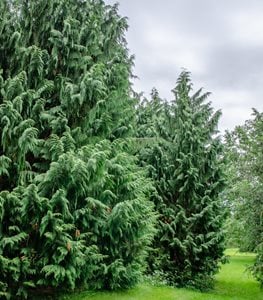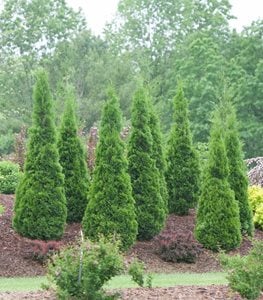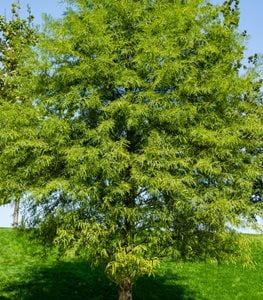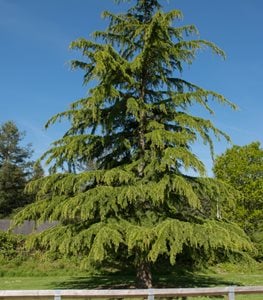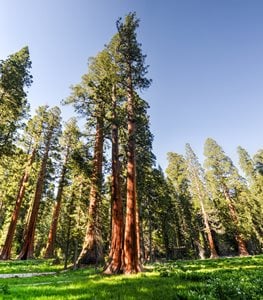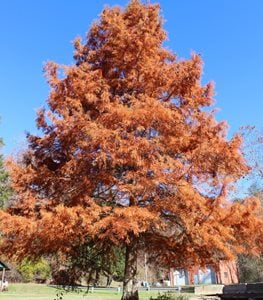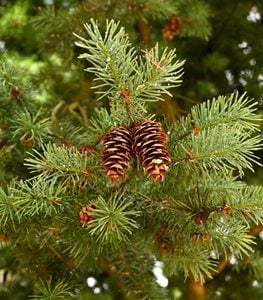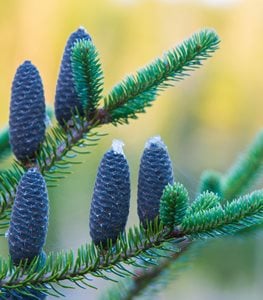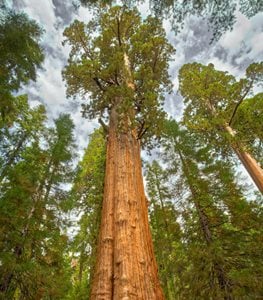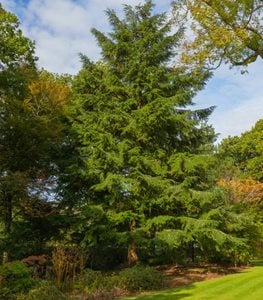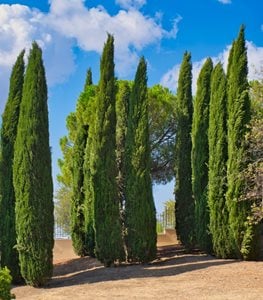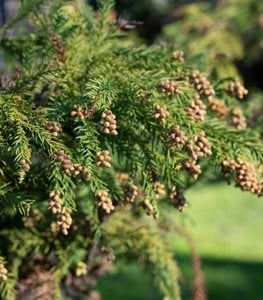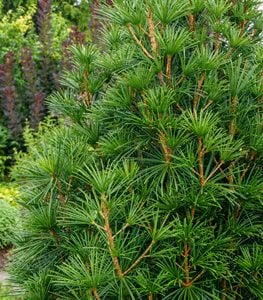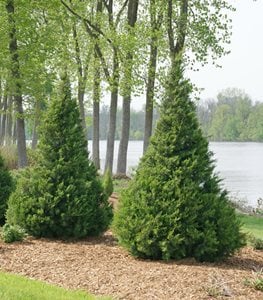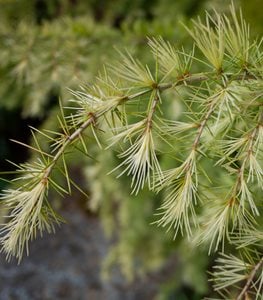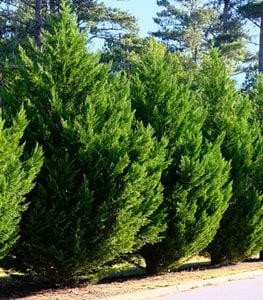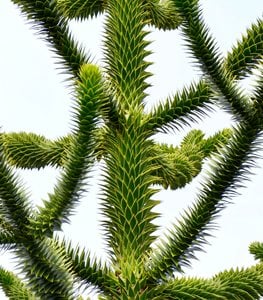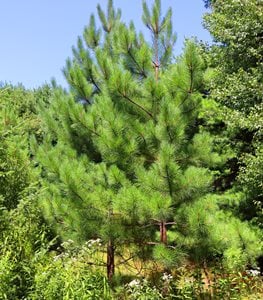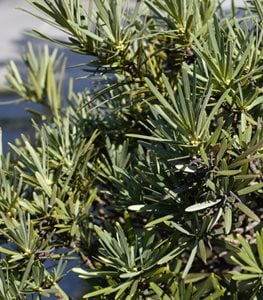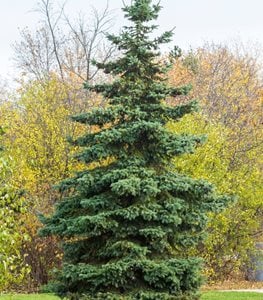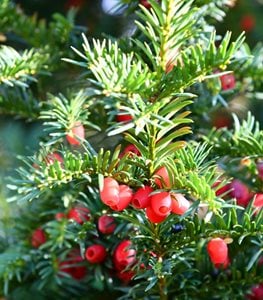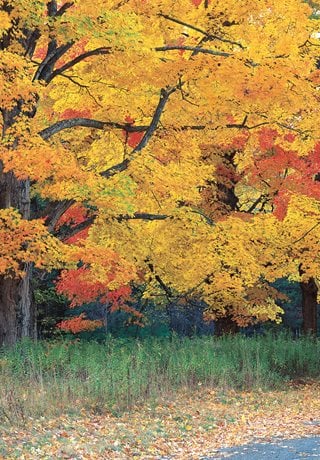Conifers: A Basic Primer for 22 Popular Types
Learn about these ancient and intriguing trees and shrubsConifers are a large group of woody, cone-bearing plants with needle-like or scale-like leaves. Often referred to as evergreens, most (though not all) conifers keep their foliage year-round. The majority of conifers are trees, though some are shrubs. They are some of the oldest plants in the world, evolving before flowering plants. There are over 600 conifer species in the world, with conifer forests being predominant in many boreal and temperate regions in the Northern Hemisphere.
Though conifers are most often associated with cold, snowy climates, they can also be found growing in warmer areas. Loblolly pine and bald cypress are found in bottomland mixed conifer forests and swamps in the southeastern U.S., while California redwood is endemic to mild coastal areas in the western U.S. The exotic monkey puzzle tree is native to the Andes Mountains in South America, while Norfolk Island pine is indigenous to the South Pacific.
Conifers make a valuable addition to the landscape, providing year-round color, texture and an array of ornamental attributes. Plants come in different sizes and shapes, with a variety of landscape uses: as ground covers, hedging, screening, or stand-alone focal points. Conifers are easy to grow and adaptable to a range of growing conditions. Here are some of the most common types of conifers.
Also see: 20 Best Dwarf Conifers to Grow
ALASKA CEDAR (Xanthocyparis nootkatensis, syn.Chamaecyparis, syn. Callitropsis)
Zones: 4-8
Exposure: Full sun to partial shade
Habit: Pyramidal weeping habit
Height/Spread: 20 to 120 feet tall, 8 to 30 feeet wide
Native to the Pacific coast from Alaska to northern California, Xanthocyparis, known as Alaska cedar or nootka cypress, is a taller tree with a graceful weeping habit. Gray-green or blue-green needles occur on flattened sprays with pointed tips. Small, green female cones develop at the tips of the branches.
ARBORVITAE (Thuja spp.)
Zones: 2-8
Exposure: Full sun to partial shade
Habit: Mounding, rounded, conical, pyramidal or weeping habit
Height/Spread: 1 to 70 feet tall, 1 to 25 feet wide
This versatile conifer, native to eastern Asia and North America, comes in a wide array of sizes and forms, from dwarf mounding types to upright towering specimens. Flattened, aromatic needles come in shades of green or gold, with tiny 1/2-inch-long cones that start out green and mature to brown. Common varieties include Eastern red cedar (Thuja occidentalis), Western red cedar (T. plicata), and ‘Emerald Green’ (syn.’Smaragd’). Learn more about growing arborvitae.
BALD CYPRESS (Taxodium distichum)
Zones: 4-9
Exposure: Full sun
Habit: Upright pyramidal habit
Height/Spread: 50 to 70 feet tall, 20 to 30 feet wide
Related to dawn redwood, this deciduous conifer is also known as swamp cypress. Native to the southeastern U.S., bald cypress is often found growing along swamplands, bayous, and rivers. The tree trunks are flared at the base, developing distinct knobby roots when growing in standing water. Delicate sprays of feathery green foliage turn vivid cinnamon-brown in fall.
CEDAR (Cedrus spp.)
Zones: 6-9
Exposure: Full sun
Habit: Upright, spreading, weeping or dwarf habit
Height/Spread: 3 to 60 feet tall and wide
Though there are many types of cedars, true cedars belong to the genus Cedrus. Originating in the Mediterranean and Himalayan regions, the aromatic needles can be stiff or soft, occurring in shades of green, gold, or blue. The most commonly grown varieties include deodar cedar (Cedrus deodara) and Atlas cedar (C. atlantica).
COAST REDWOOD (Sequoia sempervirens)
Zones: 7-9
Exposure: Full sun
Habit: Upright habit
Height/Spread: 60 to 100 feet tall, 15 to 25 feet wide, reaching up to 350 feet tall in the wild
Native to the coastlines of California and Oregon, Sequoia sempervirens, also known as coast redwood, is the tallest growing tree in the world. Named for the reddish-brown bark, these trees develop a tall straight trunk with slightly drooping branches. Soft green needles are arranged in flat sprays along the stems. These coniferous trees can take up to 400 years to mature, and can live 2,000 years or longer.
DAWN REDWOOD (Metasequoia glyptostroboides)
Zones: 4-8
Exposure: Full sun
Habit: Upright conical habit
Height/Spread: 70 to 100 feet tall, 15 to 25 feet wide
Metasequoia is one of the few conifer trees that is deciduous, losing it leaves in fall. This large tree has an elegant conical habit with upright-facing branches. Flat sprays of feathery fine-textured needles emerge bright green in spring, maturing to dark green in summer before turning brilliant shades of coppery orange-brown in fall.
DOUGLAS FIR (Pseudotsuga menziesii)
Zones: 4-6
Exposure: Full sun to partial shade
Habit: Upright pyramidal habit
Height/Spread: 40 to 80 feet tall, 10 to 20 feet wide
This stately evergreen, which is not a true fir, is a North American conifer native to the coastal region from British Columbia to central California. Pseudotsuga has reddish-brown bark, spirally arranged blue-green needles, and 4-inch brown cones that are produced in abundance. Wild specimens can reach up to 300 feet tall.
FALSE CYPRESS (Chamaecyparis spp.)
Zones: 3-9, depending on the variety
Exposure: Full sun to partial shade
Habit: Upright, mounding, pyramidal or columnar habit
Height/Spread: 5 to 130 feet tall, 2 to 25 feet wide, depending on the variety
Chamaecyparis is a coniferous tree that comes in a wide array of forms, sizes, and foliage colors including green, blue-green, chartreuse, and gold. The finely dissected foliage adds year-round color and soft texture to beds and borders. The most common types include hinoki cypress (Chamaecyparis obtusa), Japanese false cypress (C. pisifera), and Port Orford cedar (C. lawsoniana). Read more about how to grow false cypress trees.
FIR (Abies spp.)
Zones: 3-8
Exposure: Full sun to partial shade
Habit: Upright, mounding, pyramidal or conical habit
Height/Spread: 10 to 200 feet tall, 10 to 25 feet wide
Abies is a diverse genus comprising 50 species that are native to many regions in the Northern Hemisphere. Noble fir (Abies procera) and balsam fir (A. balsamea) are popular as Christmas trees for their dense symmetrical habit and aromatic needles. Abies are distinguished from other evergreen conifers by the short stiff needles that are attached at the base of the branches, and the decorative upright cones that occur in colors of brown, red, blue, or purple.
GIANT SEQUOIA (Sequoiadendron giganteum)
Zones: 6-8
Exposure: Full sun to partial shade
Habit: Upright pyramidal or conical habit
Height/Spread: 60 to 275 feet tall, 25 to 60 feet wide
Sequoiadendron is the largest tree in the world, occurring on the west slopes of the Sierra Nevada mountain range in California. They are characterized by huge trunks, a giant canopy, reddish-brown bark, and blue-green needles arranged spirally around the stems. Because of their limited range, these majestic conifers are listed as endangered. Giant sequoias are among the oldest organisms in the world, with some specimens estimated at 3,000 years old or more.
HEMLOCK (Tsuga spp.)
Zones: 3-9, depending on the species
Exposure: Full sun to partial shade
Habit: Upright pyramidal habit
Height/Spread: 40 to 150 feet tall, 20 to 35 feet wide, with some dwarf varieties
Tsuga, which is native to North America and eastern Asia, is a medium- to large-sized evergreen conifer with an elegant pyramidal shape, slightly drooping habit, and dangling cones. Finely textured green needles are short and flat, arranged symmetrically, and exude a pungent earthy scent. The two prominent native species are eastern or Canadian hemlock (Tsuga canadensis) and western hemlock (Tsuga heterophylla).
ITALIAN CYPRESS (Cupressus sempervirens)
Zones: 7-10
Exposure: Full sun
Habit: Narrow columnar habit
Height/Spread: 40 to 70 feet tall, 3 to 20 feet wide
Valued for its narrow tapered habit, Italian cypress creates a dramatic exclamation point in the landscape, and is a common landscape tree in the Mediterranean region. This statuesque tree is used as tall hedging or as screening along property borders. The dark blue-green foliage makes an attractive backdrop to ornamental beds and borders. This drought-tolerant conifer prefers dry climates and well-draining soil.
JAPANESE CEDAR (Cryptomeria japonica)
Zones: 5-9
Exposure: Full sun
Habit: Upright open habit
Height/Spread: 50 to 60 feet tall, 20 to 30 feet wide, with some dwarf varieties
Native to Japan and China, this elegant tree has a pyramidal habit with upright branching, and fragrant soft blue-green or golden needles that are spirally arranged. Some varieties stay smaller, including ‘Globosa Nana’, which reaches just 3 to 4 feet tall and wide.
JAPANESE UMBRELLA PINE (Sciadopitys verticillata)
Zones: 5-8
Exposure: Full sun
Habit: Upright pyramidal or open habit
Height/Spread: 25 to 30 feet tall, 15 to 20 feet wide
Japanese umbrella pine is named for the umbrella-like whorls of long slender needles that grow at the end of the branches. The needle clusters radiate outward, resembling the spokes of an open umbrella. This slow-growing evergreen conifer starts out with a pyramidal shape, gradually becoming more open as it matures. This ancient conifer is one of the oldest trees on earth and is considered a living fossil. It is the only member of the umbrella pine family, Sciadopityaceae.
JUNIPER (Juniperus spp.)
Zones: 2-10, depending on the variety
Exposure: Full sun to partial shade
Habit: Upright, spreading or weeping habit
Height/Spread: 6 inches to 130 feet tall, 1 to 25 feet wide
Juniperus is a large genus of 50 to 60 species of evergreen conifers that range from dwarf ground covers to towering trees over 100 feet tall. The soft, flattened, scale-like leaves occur in shades of green, blue, silver, and gold, with some acquiring winter hues of bronze or other colors. The attractive berry-like female fruits start out green and mature to blue, and are used for medicinal or ornamental purposes, as a spice, or to flavor gin. Learn more about growing juniper shrubs and trees.
LARCH (Larix spp.)
Zones: 2-7, depending on the species
Exposure: Full sun
Habit: Upright pyramidal or weeping habit
Height/Spread: 40 to 100 feet tall, 20 to 30 feet wide
Native to cooler regions of the northern hemisphere, this hardy conifer can be found growing in high-altitude forests and mountains. Larix is one of the few conifers that is deciduous, losing its leaves during the winter months. The soft, feathery green needles, which occur in tight bundles along the branches, turn brilliant yellow-gold in fall. Tamarack (Larix laricina) is a common forest tree native to North America.
LEYLAND CYPRESS (x Cupressocyparis leylandii)
Zones: 6-10
Exposure: Full sun
Habit: Upright pyramidal habit
Height/Spread: 60 to 70 feet tall, 15 to 20 feet wide
Cupressocyparis leylandii is a hybrid of Monterey cypress and Nootka false cypress, with an elegant pyramidal habit. Flattened sprays of densely packed blue-green needles occur on upright branches. This fast-growing evergreen conifer is most often used as privacy screening and hedging, but can also be grown as a tree.
MONKEY PUZZLE TREE (Araucaria araucana)
Zones: 7-10
Exposure: Full sun to partial shade
Habit: Upright spreading habit
Height/Spread: 50 to 80 feet tall, 20 to 30 feet wide
Native to Chile and Argentina, Araucaria araucana is an evergreen conifer valued for its architectural habit, textured brown bark and thick scale-like leaves that give an other-worldly appearance in the landscape. This vertical tree has an open pyramidal habit with upward branching when young, developing an umbrella-shaped canopy as it matures. Monkey puzzle tree thrives in mild maritime climates.
PINE (Pinus spp.)
Zones: 3-10, depending on the species
Exposure: Full sun to partial shade
Habit: Upright, spreading, bushy, mounding or weeping habit
Height/Spread: 10 to 130 feet tall, 3 to 10 feet wide, with some dwarf varieties
Pine is a softwood conifer in the genus Pinus, which comprises 120 species that come in a wide range of shapes and sizes. These evergreens are common in many regions of the Northern Hemisphere. The most distinctive feature of pines are the green needle clusters that occur in groups of 2 to 5. Needles may be short and stubby, or as long as 18 inches. Some of the most recognized pines include bristlecone pine (Pinus longaeva), lodgepole pine (P. contorta) eastern white pine (P. strobus), mugo pine (P. mugo), and ponderosa pine (P. ponderosa).
PODOCARPUS (Podocarpus spp.)
Zones: 3-10, depending on the species
Exposure: Full sun to partial shade
Habit: Upright, columnar or open habit
Height/Spread: 6 to 50 feet tall, 6 to 25 feet wide
This versatile evergreen tree or shrub comes in different sizes and shapes, with fine green or gold needles and colorful berries reminiscent of yew, hence the common names of yew pine or Japanese yew. The soft texture makes an attractive backdrop to other plants. Use as a ground cover, windbreak, privacy tree, or hedging.
SPRUCE (Picea spp.)
Zones: 2-9, depending on the species
Exposure: Full sun
Habit: Upright, spreading, bushy, mounding, pyramidal or weeping habit
Height/Spread: 1 to 160 feet tall, 2 to 20 feet wide, with some dwarf varieties
Picea is an evergreen tree or shrub distinguished from other conifers by the pungent four-sided needles that attach singly to small peg-like structures along the branches. There are 35 species that occur in a wide range of sizes and shapes, with foliage in shades of green, blue, or gold. Norway spruce (Picea abies) is popularly grown as a Christmas tree. Other common species include Colorado blue spruce (Picea pungens), white spruce (P. glauca), and Sitka spruce (P. sitchensis).
YEW (Taxus spp.)
Zones: 2-10, depending on the variety
Exposure: Full sun to partial shade
Habit: Upright, columnar, arching or mounding habit
Height/Spread: 4 to 60 feet tall, 4 to 20 feet wide, depending on the variety
Taxus is a tree or shrub with reddish bark, flat dark green needles, and bright red berry-like fruits. It is commonly used as formal hedging and for topiaries, with dense, finely textured foliage that is highly amenable to shearing, and is tolerant of a wide range of growing conditions. This evergreen conifer comes in many different sizes and shapes, making it a versatile landscape plant; however, all parts of the plant, especially the attractive red fruits, are highly toxic.
What is a conifer?
Conifers are woody trees or shrubs that produce seed-bearing cones and needle-shaped foliage that is usually evergreen.
Are conifer trees evergreen?
Most conifers are evergreen, keeping their foliage year-round. There are a few exceptions, including larch and dawn redwood, which lose their leaves in fall.
Related:
Evergreen Shrubs
Arborvitae Trees
Chamaecyparis Trees & Shrubs (False Cypress)
Juniper Trees & Shrubs
Winter Gardens
